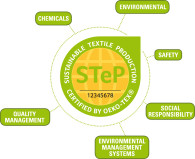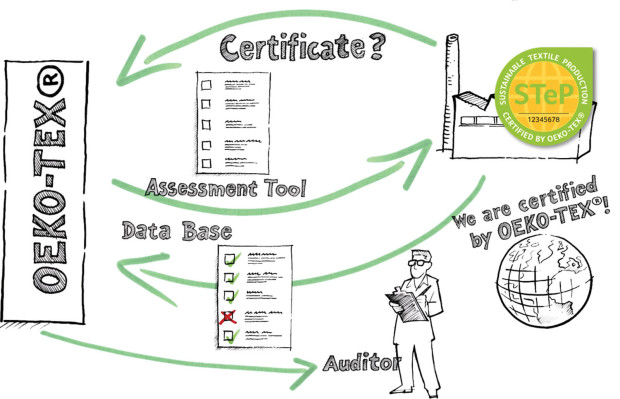The Oeko-Tex® STeP Certification for the textile industry.
 The globalization of the textile industry has created enormous pressure for textile brands, factories and supply chains to demonstrate their ability to manage and continuously improve the sustainability of their products and production facilities. Major retail brands in all sectors of the textile industry have been indicted by various stakeholders for a lack of focus on sustainability issues. Worse, in many cases, they have been singled out as being significant contributors to global pollution; having inadequate social responsibility, occupational safety and health protections for workers; and lacking the control and the ability to manage global supply chains. Stakeholders want greater accountability and transparency as the industry moves toward the goal of sustainability—but is there a business case?
The globalization of the textile industry has created enormous pressure for textile brands, factories and supply chains to demonstrate their ability to manage and continuously improve the sustainability of their products and production facilities. Major retail brands in all sectors of the textile industry have been indicted by various stakeholders for a lack of focus on sustainability issues. Worse, in many cases, they have been singled out as being significant contributors to global pollution; having inadequate social responsibility, occupational safety and health protections for workers; and lacking the control and the ability to manage global supply chains. Stakeholders want greater accountability and transparency as the industry moves toward the goal of sustainability—but is there a business case?
Most global brands no longer own or operate their own factories; rather, they exploit the economic and regulatory advantages available to them in southeast Asia, which have lowered the cost of goods for brands and retailers, and this has trickled down to consumers. The global supply chain was mostly invisible during this transition. However, with improvements in information transfer, and increased global bandwidth due to social media and 24-hour news outlets, activities in overseas factories are more visible.
Rapid globalization of information and communication has provided global stakeholders with the ability to see, almost in real time, the negative impacts of lagging regulatory enforcement and lackluster accountability by manufacturers for corporate responsibility and governance (Anderson, Schulman et al., 2001).
The case for sustainability
The business case for transparency of and investments in sustainability within supply chains is now becoming obvious as workers and the environment suffer—and the world watches. Brands are targets for attack by nongovernmental organizations (NGOs) and environmental groups because they are well known and wealthy. In the past, the business case for investments in sustainability for production facilities has been less obvious because the factories have been invisible to the consumer. When recent efforts to produce frameworks and road maps towards more sustainable production were undertaken by industry groups, major manufacturers and retailers, few stakeholders for the factories and production facilities provided input. Now, it has become obvious to all participants in the textile supply chain that transparency and sustainability for production facilities, no matter where they fit in the chain, are necessary to build resilience and credibility.
While industry working groups discover and measure the indicators of efforts toward more sustainable textile and apparel production, the metrics and performance of textile factorieswithin the sustainability arena have not been systematically assessed. Today there are several global initiatives underway that attempt to align supply chain efforts towards a focus on sustainable behaviors. Each of these initiatives, however, focuses on specific aspects of textile production, largely reacting to environmental and social challenges identified by the media and NGOs. There is a need for a unified approach that measures not only the environmental and social performance, but also the management systems in place at the factories that are responsible for continuous improvement in sustainability moving forward. Holistic, unified approaches to environmental challenges can produce good results in improving environmental and social conditions (Ausley and Moore, 2004).
Industry efforts toward a unified approach in identifying, standardizing nomenclature, and producing management structures to create more sustainable production require consensus around a grand strategy and objectives. Like the challenges faced by Dr. Karl Robert when developing the systems principles for The Natural Step®, the devil is in the details, but the details can keep the industry from seeing the forest for the trees (Robert, Schmidt-Bleek et al., 2001).
There is a new approach in the development of a quality, systems-based, holistic and transparent framework for more sustainable textile supply chain factory certification. This approach, developed through a complex intentional stakeholder dialogue process, and based on more than 20 years of history in management of textile and apparel product safety standards by the International Oeko-Tex Association, has been named the OEKO-TEX® STeP, or Sustainable Textile Production.
The OEKO-TEX® STeP system
Creating and verifying progress toward cleaner and more sustainable textile production within a particular facility or factory involves several distinct steps:
- identifying, assessing and benchmarking the unit processes (work) performed.
- identifying, assessing and benchmarking assets (engineering, material, fiscal, human capital and natural capital) towards (work) efficiencies.
- identifying, assessing, benchmarking and qualifying the systems in place to manage these assets.
- developing and creating strategies and work plans towards continuous improvements of management systems and activities.
- third-party assessment and verification of these processes and activities.
The Oeko-Tex STeP system (STeP) is a holistic certification that measures and ranks performance of any factory within the sustainability space of the textile supply chain, from fiber to finished garment production to textile logistics. To achieve certification, STeP uses the six modules as boundaries for certain unit operations or responsibilities within the management of any factory. (It should be understood that these boundaries are arbitrary and artificial for the purposes of allowing performance and benchmarking. Practically speaking, there should be seamless integration within and between these operations.)
The entire STeP system is built around the management system model and utilizes existing investments that have been made to improve performance in quality management, environmental performance, environmental management, chemical/materials management, operational health and safety, and social responsibility. The assessment tool is organized within these six modules.
Most important is the demonstration by the factory that it has an auditable and working quality management system. It can be a third-party audited system (such as ISO 9001) or an internally developed system; however, the assessment must indicate that the quality system is present and functional. Third-party systems may also be in place for integrated environmental management (ISO 14000) or for social responsibility and governance (SA 8000, WRAP, etc.).
The Higg Index 1.0 developed by the Sustainable Apparel Coalition (SAC) focuses on performance indicators in the above areas, and the STeP system follows a similar path, ranking performance against the standard. However, the STeP system goes further and also ranks performance in comparison to peers within the relevant industry segment. This performance is confirmed through audits during the three-year certification period.
The certification process
The process of certification is straightforward.
The factory applies to take a Web-based self-assessment. If approved, the factory is granted access to the assessment tool and answers all questions relevant to its category within the textile industry (spinning mill, weaving mill, dyeing and finishing, and so on).
The assessment is reviewed at the appropriate Oeko-Tex member institute office by a trained auditor. If the assessment indicates that the factory is meeting the entry level standards, it is accepted into the certification program. Any clarifications and additional documentation supporting the assessment is gathered and submitted, and then the audit is planned and conducted.
A final scoring of all six categories and a sum of all categories is calculated. Certification is awarded at three levels—entry, better, or best performance—for a three-year period. Follow-up audits are scheduled depending on level of certification; areas highlighted for improvement are noted; the process begins again during the third year of the previous certification period.
Two certification documents are produced. The first is the formal certificate with traceability, and the second is a report card with scores in all six modules and a summation of total performance.
Notation is made of the total scores and the module scores, which are used to keep trend analyses by category (spinning mills, weaving mills, etc.); this will produce a summary of sustainability performance by production category without disclosing the factory identity.
Necessary integration
Each of the six modules is weighted equally by STeP. Modules that have recognized and verified third-party certifications (such as ISO 9001, 14000, SA 8000, WRAP) reduces the work load of the auditors and contributes to a rapid and successful verification. Existing certifications also help to keep costs down.
A factory’s environmental performance is a key indicator of the effectiveness of the environmental management system, the social and human capital management systems and the chemical/resource management systems. These functions build and rely on each other in an organization that has integrated sustainability into its systems.
Minimum requirements within each module are benchmarked during the assessment phase of the certification process. If there are deficiencies within any module, these are noted so problems can be rectified before the final audits are conducted. If necessary, the Oeko-Tex Association has resources in place to assist in finding a suitable “coach” or consultant to help correct any deficiencies.
Emerging expectations
For more than 20 years, the Oeko-Tex Association, with the OEKO-TEX® Standard 100, has provided a cost-effective, empirically verified certification that textile products are “tested for harmful substances.” Today, the basis for all textile and apparel product and chemical stewardship programs is an analytically verified Restricted Substance Lists (RSL). The Oeko-Tex STeP system, with its six performance/criteria-driven modules assessed using modern Web-based technology and verified by announced and unannounced on-site audits during the three-year certification period, offers a similar path for standardization of sustainability certification.
The emerging standardization of expectations for transparency within textile supply chains is well underway. Manufacturers, brands and retailers, through groups like the SAC and the increasing level of national and international regulations, understand what will be expected in the future. The role of a certification system such as Oeko-Tex STeP is to standardize and verify the management systems and performance of all factories in the supply chains so a new standard or “norm” is created, allowing for a solid return on investment for factories seeking sustainability, as opposed to factories that are “being as bad as the law (or society) allows”(Senge, 2008).
The business case for investments in sustainability by manufacturers in the textile and apparel supply is clear once they recognize that disclosure and transparency leading to continuous improvements in sustainability creates resilience and efficiency—which will help to create strong bonds with customers and reduce costs over the short, medium and long term.
Samuel B. Moore, Ph.D., is managing director of the Hohenstein Institute America Inc., in Burlington, N.C., and adjunct associate professor at the NCSU College of Textiles in Raleigh, N.C. He will present information on the STeP program at IFAI’s Advanced Textiles Conference, Wed., Oct. 23. Contact him directly at s.moore@hohenstein.com.
References
Anderson, C. D., M. D. Schulman, et al. (2001). “Globalization and Uncertainty: The Restructuring of Southern Textiles” Social Problems 48(4): 478-498.
Ausley, L. W. and S. B. Moore (2004). “Systems Thinking and Green Chemistry in the Textile Industry: Concepts, Technologies and Benefits,” Journal of Cleaner Production 12(6): 585-601.
Robert, K.-H., B. Schmidt-Bleek, et al. (2001). “Strategic Sustainable Development: Selection, Design and Synergies of Applied Tools,” Cleaner Production 10(3): 197-214.
Senge, P. M. (2008). The Necessary Revolution: How Individuals and Organizations Are Working Together to Create a Sustainable World. New York, Doubleday.
 TEXTILES.ORG
TEXTILES.ORG





